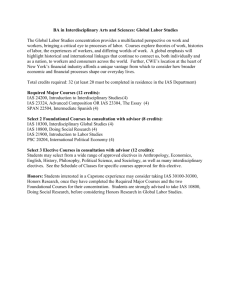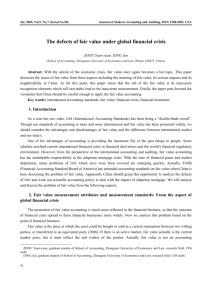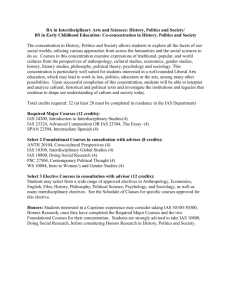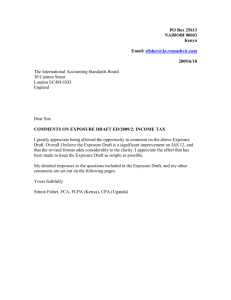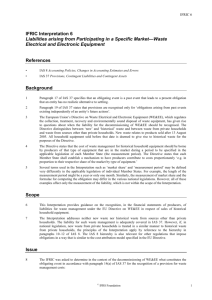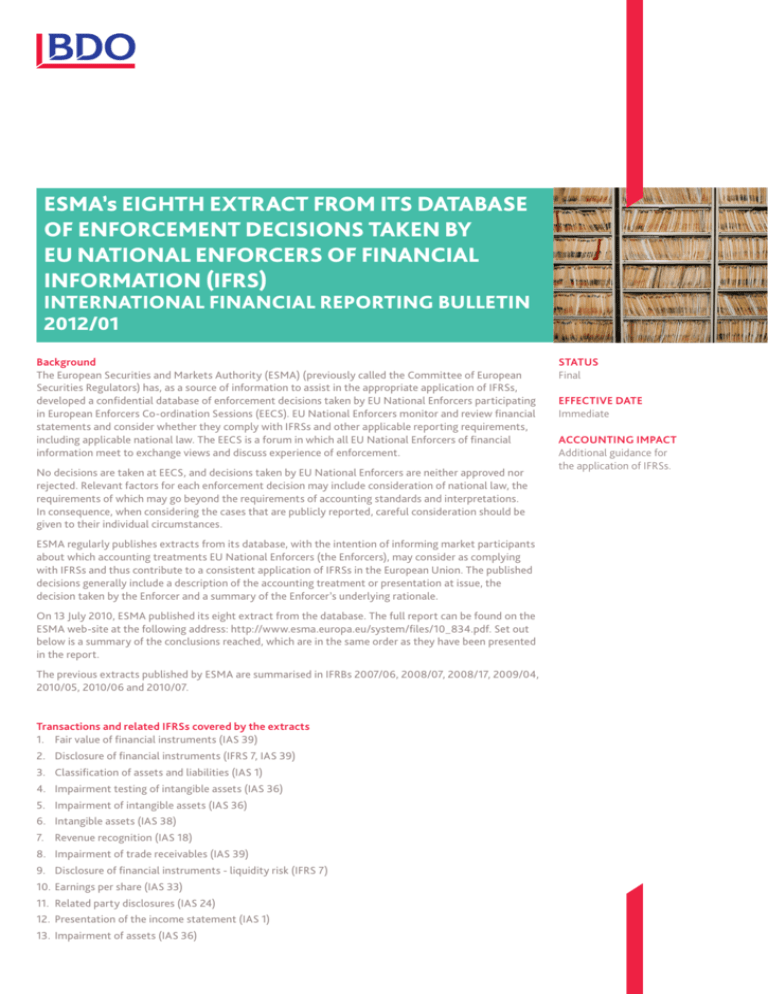
ESMA’s EIGHTH EXTRACT FROM ITS DATABASE
OF ENFORCEMENT DECISIONS TAKEN BY
EU NATIONAL ENFORCERS OF FINANCIAL
INFORMATION (IFRS)
INTERNATIONAL FINANCIAL REPORTING BULLETIN
2012/01
Background
The European Securities and Markets Authority (ESMA) (previously called the Committee of European
Securities Regulators) has, as a source of information to assist in the appropriate application of IFRSs,
developed a confidential database of enforcement decisions taken by EU National Enforcers participating
in European Enforcers Co-ordination Sessions (EECS). EU National Enforcers monitor and review financial
statements and consider whether they comply with IFRSs and other applicable reporting requirements,
including applicable national law. The EECS is a forum in which all EU National Enforcers of financial
information meet to exchange views and discuss experience of enforcement.
No decisions are taken at EECS, and decisions taken by EU National Enforcers are neither approved nor
rejected. Relevant factors for each enforcement decision may include consideration of national law, the
requirements of which may go beyond the requirements of accounting standards and interpretations.
In consequence, when considering the cases that are publicly reported, careful consideration should be
given to their individual circumstances.
ESMA regularly publishes extracts from its database, with the intention of informing market participants
about which accounting treatments EU National Enforcers (the Enforcers), may consider as complying
with IFRSs and thus contribute to a consistent application of IFRSs in the European Union. The published
decisions generally include a description of the accounting treatment or presentation at issue, the
decision taken by the Enforcer and a summary of the Enforcer’s underlying rationale.
On 13 July 2010, ESMA published its eight extract from the database. The full report can be found on the
ESMA web-site at the following address: http://www.esma.europa.eu/system/files/10_834.pdf. Set out
below is a summary of the conclusions reached, which are in the same order as they have been presented
in the report.
The previous extracts published by ESMA are summarised in IFRBs 2007/06, 2008/07, 2008/17, 2009/04,
2010/05, 2010/06 and 2010/07.
Transactions and related IFRSs covered by the extracts
1. Fair value of financial instruments (IAS 39)
2. Disclosure of financial instruments (IFRS 7, IAS 39)
3. Classification of assets and liabilities (IAS 1)
4. Impairment testing of intangible assets (IAS 36)
5. Impairment of intangible assets (IAS 36)
6. Intangible assets (IAS 38)
7. Revenue recognition (IAS 18)
8. Impairment of trade receivables (IAS 39)
9. Disclosure of financial instruments - liquidity risk (IFRS 7)
10. Earnings per share (IAS 33)
11. Related party disclosures (IAS 24)
12. Presentation of the income statement (IAS 1)
13. Impairment of assets (IAS 36)
STATUS
Final
EFFECTIVE DATE
Immediate
ACCOUNTING IMPACT
Additional guidance for
the application of IFRSs.
2
IFRB 2012/01 ESMA’s EIGHTH EXTRACT FROM ITS DATABASE OF ENFORCEMENT DECISIONS TAKEN BY EU NATIONAL ENFORCERS OF FINANCIAL INFORMATION (IFRS)
Summary of extracts
1. Fair value of financial instruments (IAS 39)
The issuer, a bank, valued shares in company A that were traded on
a regulated market at about 50% above the quoted market price.
The shares were held as collateral for three loans that were subject
to impairment. The bank initiated negotiations to sell the shares as
a consequence.
3. Classification of assets and liabilities (IAS 1)
The main activity of a closed-ended fund is to invest in shares and
debt on listed Asian exchanges with the objective of achieving long
term capital appreciation. The manager’s report indicated it was
not the fund’s intention to invest in short term trading positions.
However, all assets and liabilities were classified as current in the
statement of financial positions.
The bank expected to sell the shares at a price 50% above the
quoted price. The expectation was based on indicative, nonbinding offers from potential buyers that were unavailable to
the public. The bank also provided various valuation techniques
including DCF-calculations to support the estimated share price.
The issuer was of the opinion that company A’s shares were not
traded on an active market.
The enforcer found that the classification of all assets and
liabilities as current did not comply with the requirements of IAS 1.
Based on that information, the issuer valued the shares 50%
above market price which reduced its impairment charge by
12 million Euros.
–– Investments had not been purchased for trading
The enforcer concluded that the shares were traded in an active
market and therefore, that they should be valued at their quoted
price in accordance with AG 71 of IAS 39.
Trading had occurred on 98% trading days with more than
1,000 shares being traded on 62% of these days. The enforcer did
not find any evidence that trades did not occur between willing
parties at arm’s length. The possible bid offers and valuation
techniques were disregarded as the enforcer concluded that the
shares were traded on an active market.
2. Disclosure of financial instruments (IFRS 7, IAS 39)
The issuer issued limited recourse debt in series and invested
the funds raised in corporate bonds and loans. The notes to its
financial statements stated that the fair values of the financial
instruments was either based on quoted market prices or dealer
price quotations and that they were reliably determined within
a range of estimates. No further disclosure about the fair value
of the instruments was provided. This did not allow readers to
determine the extent that fair values based on market quotations
or valuation techniques. There was also no apparent disclosure
about reasonably possible changes in assumptions that would
result in significantly different fair values being recognised.
The enforcer concluded that the issuer had inadequately disclosed
the basis for the determinations of the fair value of the financial
instruments as required by IFRS 7 paragraph 27 and that there
was insufficient information to allow users to understand whether
a reasonably possible change in one or more of the assumptions
would significantly change the fair values.
The issuer had chosen to present all assets and liabilities as current
in the light of the following:
–– The investments were traded on recognised exchanges and could
be converted to cash within one year
–– Over 77% of the portfolio of investments had been purchased
over 1 year ago
The enforcer did not consider the current classification as
appropriate given the requirements of paragraph 66 and 67 of
IAS 1 and the explanations of the issuer. An entity shall present
current and non-current assets and current and non-current as
separate classification on the face of the statement of financial
positions as stated in IAS 1 paragraph 60. IAS 1 paragraph 66
states that an entity shall classify an asset as non-current unless:
(a) It expects to realise the asset, or intends to sell or consume it,
in its normal operating cycle;
(b) It holds the asset primarily for the purpose of trading;
(c) It expects to realise the asset within twelve months after the
reporting period; or
(d) The asset is cash or a cash equivalent (as defined in IAS 7)
unless the asset is restricted from being exchanged or used to
settle a liability for at least twelve months after the reporting
period.
4. Impairment testing of intangible assets (IAS 36)
The issuer had constructed a database of information. Costs
incurred in bringing information to a higher standard of
performance are capitalised. Maintenance costs are expensed to
profit or loss. The database is accounted for as a mainly internally
developed intangible with an indefinite useful life.
The issuer tested the database for impairment annually as it is
required for intangible assets with an indefinite useful life using
estimated future cash flows which include:
Paragraph AG 72 of IAS 39 states that “The appropriate quoted
market price for an asset or liability to be issued is usually the
current bid price, and for an asset to be acquired or liability held,
the asking price.”
–– Maintenance expenses
IFRS 7 paragraph 27 (a) requires an entity to disclose the methods
and, when a valuation technique is used, the assumptions applied in
determining fair values of each class of financial assets or financial
liabilities. IFRS 7 paragraph 27 (c) requires disclosure of whether the
fair values recognised or disclosed in the financial statements are
determined in whole or in part using a valuation technique based
on assumptions that are not supported by prices from observable
current market transactions. For fair values that are recognised
in the financial statements, if changing one or more of those
assumptions to reasonably possible alternative assumptions would
change the fair value significantly, the entity is required both to
state that fact and to disclose the effect of those changes.
–– The expected increase in turnover resulting from the above
mentioned cash outflows
–– Capital expenses incurred in bringing the data to a level suitable
for use
The enforcer found that the determination of the cash flows used for
impairment testing did not comply with IAS 36 paragraph 44 which
requires estimated future cash flows for value in use calculations to
be measured at the current condition of the asset. These would not
include cash inflows and outflows that are expected to arise from
a future restructuring to which an entity is not yet committed or
improving or enhancing the asset’s performance.
Based on the issuers description of the cash flows utilised the
enforcer concluded that they were not estimated for the asset in
its current condition as they included cash out flows relating to
IFRB 2012/01 ESMA’s EIGHTH EXTRACT FROM ITS DATABASE OF ENFORCEMENT DECISIONS TAKEN BY EU NATIONAL ENFORCERS OF FINANCIAL INFORMATION (IFRS)
improvement maintenance and capital expenses and additional
cash inflows resulting from the preceding cash out flows.
5. Impairment of intangible assets (IAS 36)
37% of total assets of a developer specializing in online games
were represented by mainly internally generated intangible
assets that generated 100% of the issuer’s revenue. 90% of total
intangible assets were allocated to two Cash Generating Units
(CGU 1 and CGU 2).
The issuer reported an impairment charge in respect of the two
CGUs representing 63% of the consolidated result before tax. The
financial statements did not disclose the events and circumstances
that led to the impairment nor allocate the impairment charge to
the separate CGUs.
The events and circumstances that resulted in an impairment
charge to CGU 1 were publicly known in the market, those
responsible for the impairment in CGU 2 were not. There was
no information provided indicating that part of the impairment
charge related to CGU 2. Indeed the intangible allocated to CGU 2
included intangible assets under development for which the
product was expected by the market to be successful.
The enforcer found that the issuer had not complied with the
disclosure requirements of IAS 36, in that neither the events and
circumstances that led to the impairment loss (paragraph 130(a))
nor the amounts attributable to the two CGUs were separately
disclosed (paragraph 130 (d) (ii)).
The issuer had disclosed that cash flows are driven by the number
of paying customers and that for managements this was the most
important factor when estimating future cash flows. The issuer
had also described the recoverable amounts in narrative and that
the reader could conclude that the number of paying customers
for CGU 1 was less than expected. The issuer also noted that
the directors’ report explained that CGU 1 had not developed
as expected. Notwithstanding these disclosures, the enforcer
concluded that the relevant information required by IAS 36 was
not provided.
6. Intangible assets (IAS 38)
A professional football club had significant intangibles assets that
mainly related to acquired players’ registration rights comprising
registration and agents fees in its financial statements. They
were amortised using the straight line method over the life of the
contracts.
Agent fees, which are common in the football business, are paid
by clubs to player’s agents when a player is transferred or extends
his contract. The club believed that the fees met the criteria for
capitalisation as intangibles because they are directly attributable
to the costs of a player’s contract.
The enforcer accepted the accounting treatment for payments
relating to transfers as well as for payments for contract
extensions.
For payments relating to new transfers the enforcer agreed
that payments met the example set out IAS 38 paragraph 28:
“professional fees arising directly from bringing the asset to its
working condition”.
For payments relating to extended contracts the enforcer based its
conclusion on IAS 38 paragraphs 68 (a) and 18 which applies “to
costs … incurred subsequently to add to, replace part of, or service
it”. Noting that agents fees paid on the extension of contracts can
be considered cost incurred to service the registration rights.
3
7. Revenue recognition (IAS 18)
In 2004 the issuer launched an on-line video game with the
following characteristics:
–– In order to be able to play, the player has to buy an initial pack
and a monthly subscription.
–– It is impossible to play without an on-line subscription.
–– The initial pack is sold with a free subscription for one month. The
price of the initial pack is equivalent to the price of a one-month
subscription.
–– It is a “multi-player” game, which means that the issuer has an
implicit obligation to maintain its IT capacity in order to enable
players around the world to play with each other.
–– The player may also buy expansion packs. An expansion pack
is more expensive than the initial pack and does not include a
free subscription. It provides players with new options (new
characters, new battlegrounds, additional outdoors, rated
matches, etc.) that are not available with the initial pack.
Whether or not a player buys the expansion pack, the price of the
monthly subscription remains the same. New expansion packs
generate new customers. They also encourage former customers
to re-subscribe to the game.
–– The initial pack is necessary in order to use the expansion pack.
The licence agreement explicitly states that there is no legal
obligation to maintain the online game for the issuer. Based on the
products success it would however make no sense for the issuer to
stop maintaining the IT-platform.
Until 30 September 2008 the sale of the initial or the extension
pack was recognised when a player bought the pack. The monthly
subscription was spread over the subscription period.
The issuer launched a second extension pack in October 2008
following the success of the product.
The vast majority of players subscribe for an average of ten month.
The issuer reconsidered its revenue recognition policy and
concluded that that the different elements of the game were so
inter-linked that considering the sale of the expansion pack and the
monthly subscription as two separate transactions did not reflect
the substance of the sale. Indeed the commercial effect of the sale
of the expansion packs cannot be understood without reference
to the monthly subscription. These elements of the sale should,
therefore, be considered together in accordance with paragraph 13
of IAS 18.
Therefore, as of 30 September 2008, the issuer changed its
accounting policy for revenue, and recognised the sale of the
expansion packs over a 10-month period. The change in accounting
policy was applied retrospectively in accordance with IAS 8.
The Enforcer accepted the accounting treatment of the issuer.
IAS 18 paragraph 13 states the in certain circumstances it is
necessary to apply recognition criteria to two or more transaction
together in order to reflect the substance of the transaction.
The enforcer accepted the issuer’s argument that the sale of the
extension pack and the monthly subscription should be dealt
together in accordance with the above paragraph. Recognising the
revenue from the sale of the extension pack immediately would also
not reflect the issuer’s implicit obligation to maintain its IT capacity.
The enforcer also accepted that the new accounting treatment met
the criteria of paragraph 14(b) of IAS 18 to be treated as a change
in accounting policy to be applied retrospectively.
4
IFRB 2012/01 ESMA’s EIGHTH EXTRACT FROM ITS DATABASE OF ENFORCEMENT DECISIONS TAKEN BY EU NATIONAL ENFORCERS OF FINANCIAL INFORMATION (IFRS)
8. Impairment of trade receivables (IAS 39)
9. Disclosure of financial instruments – liquidity risk (IFRS 7)
An issuer stated in the notes that trade receivables were initially
recognised at fair value and subsequently at amortized cost based
on the effective interest method less provisions for impairment.
The provision being calculated as the difference between the
carrying amount and the present value of the estimated future
cash flows discounted at the original estimated interest rate.
At year end the group’s and the issuer’s trade and other receivables
overdue between 170 and 1031 days were as follows:
Group
Name
(debtor)
Outstanding
amount
Debt overdue
in days
Invoice payment
deadlines (in days)
Entity A
42,270
394
60/90
Entity B
324,690
450
60
Entity C
34,110
245
15
Entity D
20,000
170
60
Entity E
15,680
452
60/90
Entity F
99,000
256
15
Total
535,750
Group’s trade and other amounts receivable from unrelated entities
Name
(debtor)
Outstanding
amount
Entity A-F
535,750
(see above)
Issuer’s
subsidiary H
11,865,000
Total
12,400,750
Debt overdue
in days
Invoice payment
deadlines (in days)
(see above)
(see above)
1,031
30/60
The issuer expected to receive all the amounts due and had
therefore not discounted any amounts with the original effective
interest rate. However it had recognised an impairment of 535,750
for the amounts due from Entities A-F.
The enforcer concluded that the accounting treatment did not
comply with IAS 39 in a number of respects relating to the
measurement of the receivables.
Paragraph 59 (b) in IAS 39 states that evidence for impairment of
financial assets includes default in principal payment. In the view
of the enforcer the fact that receivables were overdue is objective
evidence for impairment.
According to IAS 39 paragraph 63 the issuer should have measured
its receivables by discounting future cash flows with the original
effective interest rate. The enforcer did not accept the issuer’s
argument that it was not in the position to measure its receivables
from subsidiary H due to uncertainties in the property market.
A fund management company (the issuer) holds portfolios of
investments that are measured at fair value. At year end the issuer
revalued its investment to fair value. The fair values of certain
hedge funds held, were based on net asset values published by the
hedge fund managers.
The issuer confirmed that expected requests for additional funding
from funds are taken into consideration in monitoring cash flow
requirements. These calls were not disclosed in the liquidity
risk disclosure because the correspondence was regarded as
confidential by the issuer.
The enforcer found that the disclosures of the issuer’s liquidity
risk did not comply with IFRS 7 paragraph 34 (a) which requires
summary quantitative information based on information provided
to key management personnel.
The enforcer also noted that there is no exemption in IFRS 7
regarding confidentially.
10.Earnings per share (IAS 33)
An entity A was founded in March 2006. Its 0.5 million shares
were held by listed entity B. On 29 June 2006 new shares in
tranches of 14.5 and 60 million were issued and transferred to
entity B in exchange for its demerged assets and liabilities. Entity B
offered 15 millions of the shares to the public and the issuer was
listed on 30 June 2006.
The demerger was accounted for using the pooling of interest
method. The financial statements for 2006 were based on
company B’s historical (book) values. Entity A’s profit and loss
statement covered the entire year ending 31 December 2006.
Earnings per share (EPS) were calculated by dividing the loss for the
year by the weighted average number of shares outstanding, which
was calculated as 75 million. The number of 75 million was equal
to the amount of outstanding shares as at year end did not appear
to be the average number of shares outstanding during the year.
Disclosure was not provided on how entity A had accounted for
the demerger, or the method adopted to determine the average
number of shares.
The enforcer accepted the issuer’s accounting for the demerger
and concluded that the calculation of EPS complied with IAS 33.
The calculation of EPS in a business combination accounted for
using the pooling of interest method is not covered in IAS 33.
The principles of the standard however imply that there should
be a consistency between earnings and the capital involved to
generate those earnings. It is in accordance with that principle
that the shares issued in connection with the demerged assets are
included as if they were outstanding at the beginning of the period
presented.
11. Related party disclosures (IAS 24)
The issuer’s financial statements included a note on related
party transactions that stated that key management personnel
comprised the Board of Directors. A cross-reference was provided
to the Report of Directors’ Remuneration section which was
outside the audited financial statements. The report did also not
provide all information requested by IAS 24 (2003) paragraph 16
(IAS 24 (2009) paragraph 17).
The enforcer found that the issuer had not complied with IAS 24
(2003) because the information provided was not within the
consolidated financial statements, was not subject to audit and
also missed disclosures required by paragraph 16.
IFRB 2012/01 ESMA’s EIGHTH EXTRACT FROM ITS DATABASE OF ENFORCEMENT DECISIONS TAKEN BY EU NATIONAL ENFORCERS OF FINANCIAL INFORMATION (IFRS)
12.Presentation of the income statement (IAS 1)
A group who is primarily engaged in the insurance business split its
return on investment income between two separate line items:
–– A gain for item “investment income - longer term rate of return”
and
–– A loss for item “investment income - fluctuation” (the loss being
the difference between the actual short term and the expected
longer term investments returns during the period).
The gain was included within “Operating profit” while the loss was
presented below that subtotal.
The enforcer found that the presentation did not comply with the
requirements of IAS 1 relating to the presentation of the income
statement.
While IAS 1 neither requires nor precludes disclosure of results
of operating activities on the face of the income statement,
paragraph BC 56, IAS 1 states that where an entity discloses such
an amount it should be representative of activities that would
normally be considered to be “operating”, even if the exclusion of
such items from operating profit had been industry practice.
The enforcer believed that the actual return for a period would
seem to be of a clear operating nature. Notwithstanding that it
may reflect actual short term, rather than expected longer term
performance.
13.Impairment of assets (IAS 36)
In 2008 to test its goodwill for impairment an issuer used the
cost of debt as an input to the determination of the WACC used
as discount rate. The issuer used the risk free rate adjusted by the
company specific average credit spread of its outstanding debt.
The banks had not recently increased the credit spreads or made
an indication that they had the intention to do so. The issuer did
also not have any need for additional funding and did not need to
repay its outstanding loans before 2010. The issuer did therefore
not see a need to use a higher credit spread notwithstanding that
it was aware that its current credit spread would have been higher
for new funds due to the financial crisis.
The enforcer concluded that the calculation of the discount rate
was not wholly in accordance with the requirements of IAS 36
because the discount rate applied did not reflect the market
assessment of the contributing factors.
IAS 36 paragraphs 55 and 56 specify that a rate that reflects the
current market assessment should be used for impairment testing.
The inputs to the determination of the discount rates should be
based on current credit spread levels in order to reflect the current
market assessment of the time value of the money and asset
specific risks.
5
This publication has been carefully prepared, but it has been written in general terms and should be seen as broad guidance only. The publication cannot be relied upon to cover
specific situations and you should not act, or refrain from acting, upon the information contained therein without obtaining specific professional advice. Please contact your
respective BDO member firm to discuss these matters in the context of your particular circumstances. Neither BDO IFR Advisory Limited, Brussels Worldwide Services BVBA,
BDO International Limited and/or BDO member firms, nor their respective partners, employees and/or agents accept or assume any liability or duty of care for any loss arising
from any action taken or not taken by anyone in reliance on the information in this publication or for any decision based on it.
Service provision within the international BDO network of independent member firms (‘the BDO network’) in connection with IFRS (comprising International Financial Reporting
Standards, International Accounting Standards, and Interpretations developed by the IFRS Interpretations Committee and the former Standing Interpretations Committee), and
other documents, as issued by the International Accounting Standards Board, is provided by BDO IFR Advisory Limited, a UK registered company limited by guarantee. Service
provision within the BDO network is coordinated by Brussels Worldwide Services BVBA, a limited liability company incorporated in Belgium with its statutory seat in Brussels.
Each of BDO International Limited (the governing entity of the BDO network), Brussels Worldwide Services BVBA, BDO IFR Advisory Limited and the member firms is a separate
legal entity and has no liability for another such entity’s acts or omissions. Nothing in the arrangements or rules of the BDO network shall constitute or imply an agency relationship
or a partnership between BDO International Limited, Brussels Worldwide Services BVBA, BDO IFR Advisory Limited and/or the member firms of the BDO network.
BDO is the brand name for the BDO network and for each of the BDO member firms.
© 2012 BDO IFR Advisory Limited, a UK registered company limited by guarantee. All rights reserved.
1201-04
www.bdointernational.com



